|
Byron Burt was born in Italy on August 18, 1889. According to an immigration form I examined at ancestry.com, Burt, at age 2, and his parents, returned to the United States aboard the German steamer S.S. Rhaetia on February 29, 1892. Both his parents were U.S. citizens. He had an older sister, Carmen, 4. His father was identified on the immigration form as an engineer.
Eight years later, the U.S. Census for 1900 listed the Burt family as boarders in a house at 117 McCallie Avenue, Chattanooga, TN. when I checked, that address was absent from Google Earth. Besides his father and mother, Alice, Burt had his sisters Carmen and Alice (4) living in the same house, along with a couple dozen others. His father was coded as an electrical engineer. Indeed, Burt, Sr. was an officer of a local lighting company, and later moved to South America to extend trade to Buenos Aires, Rio de Janiero and Valparaiso. Burt, Sr. was covered in many dozens of news articles from ca. 1899-1930s.
B.T. Burt Distinguished Service Cross, 1918 (Source: Link)
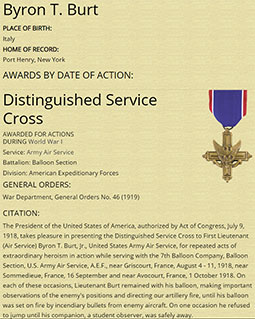 |
On August 6, 1910 at age 20 he married Gillian Dut Bois [Dut Bois, sic], age 22, in Mexico. On June 6, 1915, a U.S. immigration form documented Burt, his wife and young son, Ernest (3), sailing on the S.S. Morrow Castle from Vera Cruz, Mexico to New York. They might have been in Mexico to visit his parents. According to the Rutland News (VT), November 23, 1917, his father was then working with the Mexican Power & Light Company in Mexico City. During the same time period, Burt's sisters became part of Chattanooga society, with Carmen fêted with a society wedding to a military man in 1918.
I have no information about the Burt's life between 1915 and 1917, but the Chattanooga Daily Times, February 9, 1917 documented that Gillian passed away near that date, below.
Chattanooga Daily Times, February 9, 1917 (Source: ancestry.com)
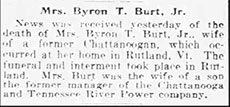 |
Eighteen months later the Rutland News, September 18, 1918 mentioned Ernest traveling to Mexico with his grandmother to visit Mr. Burt, Sr. Later documents made no mention of him living with Burt, Jr. I do not know what happened to him.
Burt served in Europe during WWI with the 7th Balloon Company. He was awarded the Distinguished Service Cross for his exploits between August and October 1918. His award is above , from the Military Times Web site. The New York Tribune, February 2, 1919, below right, provided context for the award, and the awards of several other pilots. When he returned to the U.S. in December, he was assigned to the balloon school in Arcadia, CA.
The New York Tribune, February 2, 1919 (Source: newspapers.com)
 |
A month after he returned to the U.S., the Rutland News, January 20, 1920, announced the marriage of Burt to Willie Nancy Caulkins (1883-1975). Announcement also appeared in the Chattanooga Daily Times, January 4, 1920.
Rutland News, January 20, 1920 (Source: newspapers.com)
 |
The 1920 Census placed Burt, at age 29, living in military accomodations at Ft. Bliss, El Paso, TX. He was now recently married to Willie, 35. His son, Ernest, who now would be eight years old, was not living with them. Burt, and his fellow military neighbors, were members of the First Surveillance Group.
Chattannooga Daily Times, September 5, 1920 (Source: newspapers.com)
 |
Later that year, the Chattannooga Daily Times, September 5, 1920, left, recorded Burt at Chattanooga enroute to Birmingham, AL as a race competitor with an army balloon. Willie joined him in Chattanooga. Confusing is the journalist's statement that Birmingham is close to the Gulf of Mexico. It is about 200 miles inland, and northerly winds would carry a balloon toward the Gulf, not away from it. So much for geography and meteorology.
No details were given regarding the race itinerary. This race did head north, however, beginning September 25th at 5PM. Burt was in command of balloon #2 of a field of five. The three pilots who traveled the farthest would represent America in the James Gordon Bennett cup race to be held October 23rd.
An earlier balloon race, in September of 1919, resulted in an incident which was documented over two years later in the Santa Fe New Mexican, February 22, 1922, below. The article described a dunking Burt endured during the race. This incident occurred in September, but a half day in Lake Michigan in any season would be a challenge because of the frigid water.
Santa Fe New Mexican, February 22, 1922 (Source: newspapers.com)
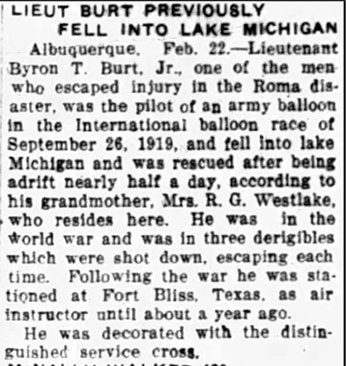 |
Apropos the article at right, Burt was assigned to Norfolk, VA to help test the army's airship Roma in 1922. Roma was built in Italy after WWI and sold to the U.S. army in late 1921 for the bargain price of $185,000. A U.S. crew was sent to Italy (Burt was not with that crew) to fly the machine before it was disassembled and shipped back to Norfolk, VA.
The testing in Italy was less that satisfactory, because the balloon fabric was in poor shape and the installed engines were underpowered. The Italian spirit of hospitality did not help, with late nights of dinners and drinking (the U.S. was immersed in Prohibition) detracting from what should have been a serious evaluation. Regardless, the machine was accepted and shipped to Norfolk, VA.
Back in the U.S., Burt was assigned at Norfolk to help with the testing probably because of his considerable balloon experience. The final flight in the U.S., with Burt aboard, occurred on February 21, 1922. Long story short, the Air Force Institute of Technology (AFIT) summarized the final flight of the Roma as follows at the link. At the link you'll find photographs and technical specifications of the Roma, identification of its crew, as well as photos of the aftermath of its crash.
Summary of the November 21, 1922 Flight of the Airship Roma (Source: AFIT)
"1245. Preflight complete. On board: 45 officers, enlisted & civilians. (Operational crew size:18)
1345. Roma lifts off tail first, heads toward Chesapeake Bay at approximately 900 ft AGL. Capt Mabry orders “cruising speed”
Crew member operating elevator control has trouble keeping nose up
Observers near Ft. Monroe notice the nose looks “crinkled”
Roma heads over water towards Willoughby Spit, crosses Willoughby Bay towards Naval Station
Crew notices upper curve of nose is flattening
1415. Less than 1000 ft AGL, Roma pitches 45 degrees down. Elevator unresponsive
Capt Mabry orders engines cut. Center and aft stop, forward engines continue to run
Keel buckles, elevator-rudder swings loose
Crew attempts emergency landing at Norfolk Country Club Golf Course. Does not reach it
Roma impacts ground, contacts high voltage lines
Sparks ignite hydrogen, which ignites gasoline tanks
Resulting inferno completely destroys Roma
Fatalities: 34 of 45 on board" |
Chicago Tribune, February 23, 1922 (Source: newspapers.com)
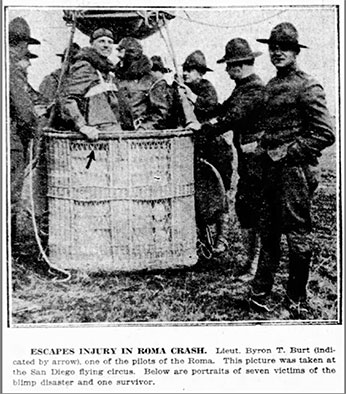 |
Eleven of 45 crew survived. Burt was among them, and he was stable enough to help in the immediate rescue of some of his fellow crew members. The photograph, left, appeared in the Chicago Tribune, February 23, 1922 and shows Burt at the arrow on an unidentified date in San Diego, CA.
The final analysis of the crash determined that the airship's structure was not adequate to accept the more powerful Liberty engines installed in the U.S. by the army (Italian-made Ansaldo engines were original equipment), and that hydrogen was highly unsafe for airships (but consider the Hindenburg disaster a decade and a half later, which only then resulted in the ban of hydrogen from use in airships). Parenthetically, Pitcairn Field Register pilot Denis Mulligan was on the team that investigated the Hindenberg crash.
The following photograph, from the Hampton History Museum, Hamton, VA., is the earliest image I could find of Burt. It shows him, third from right, as a member of the crew of the ill-fated airship just days before its final flight. Dozens of news articles from across the country covered the crash and ist aftermath. According to the Chattanooga Daily Times, August 13, 1922, Burt was assigned to the Panama Canal Zone shortly after the accident. He didn't stay there long, because the article discussed his transfer to San Antonio around that date.
Byron T. Burt, 3rd From Right, November 15, 1921, Langley, VA (Source: Link)
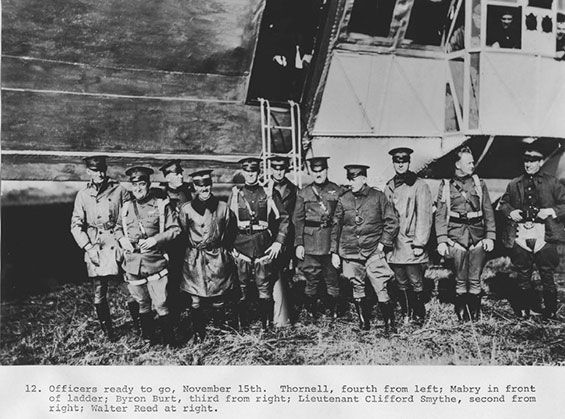 |
San Bernardino County Sun, May 31, 1928 (Source: newspapers.com)
 |
Burt visited Tucson at least three times. The first record in the Register was Thursday, May 30, 1928 at 8:15PM. He flew the deHavilland DH he clearly identified in the Register as 32512. I found no record of this number assigned to any army aircraft. If you have and infornation regarding this airplane, please let me KNOW. Regardless, he carried a single passenger, Lt. W.C. White. Based at Riverside, CA, March Field, they arrived at Tucson from Douglas, AZ. They remained overnight, departing the next morning at 10:00AM to Riverside. He noted simply in the remarks column of the Register, "Ferry." Another deHavilland flown by Clinton W. Davies was following the same itinerary. Burt and Davies' aircraft appeared to be a flight of two. Davies flew 31-561 and carried Capt. C.L.Mullins.
Indeed, they were a flight of two minus one. The San Bernardino County Sun, May 31, 1928 carried the tragic article exhibited at left. Just hours before their evening arrival at Tucson, Burt and Davies had witnessed the leader of their flight perish in a flaming crash at Douglas. The dead aviator was Register signer B.V. Baucom.
Burt's second and final visits were on Thursday, December 26, 1929 at 1:00PM and on Thursday, January 2, 1930 at 3:40 PM. He carried Lt. Alvin C. Kincaid both times. The first time they flew 27-363, a Curtiss A-3 Falcon. Based at San Antonio, TX, their recorded itinerary was westbound from El Paso, TX to Riverside. Their January visit appeared to be a return flight to San Antonio. The 1930 Census placed him at age 40 at Duncan Field in San Antonio, TX. According to the Census, he and Willie were neighbors with fellow Register pilot Frank Lahm.
The 1939 city directory for Montgomery, AL documented him (now a major) living there at 235 West Drive. Just two years later, as WWII threatened, Burt, as a lieutenant colonel, was assigned to command Sunset Field, then under-construction in Spokane, WA. The assignment of Work Projects Administration laborers to work on that "certified defense project" was announced in The Spokesman-Review (Spokane), March 11,1941.
The 1940 Census placed him an Willie living in army housing in Montgomery, AL. He was an officer, with an annual salary of $6,000, a very good wage for 1940. The Census listed him as having completed two years of college.
Burt served during WWII in mostly training command positions at various Army Air Corp facilities around the country, including Marietta, GA, Alexandria, LA and Geiger Field. The above-referenced Sunset Field became Geiger Field in 1941 with Burt commanding, below from the Idaho Falls (ID) Post-Register, June 21, 1942. Geiger Field was a B-17 heavy bomber training field.
Idaho Falls Post-Register, June 21, 1942 (Source: newspapers.com)
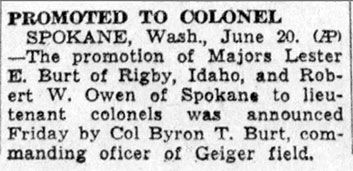 |
As D-Day approached, Burt was recognized for his work with a Legion of Merit award as documented in the Medford Mail Tribune (OR), May 7, 1944, below.
Medford Mail Tribune, May 7, 1944 (Source: newspapers.com)
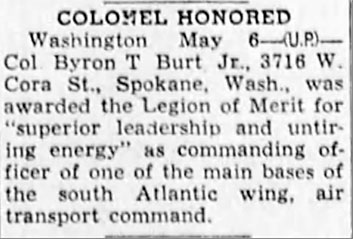 |
B.T. Burt, Grave Marker, February 9. 1969 (Source: ancestry.com)
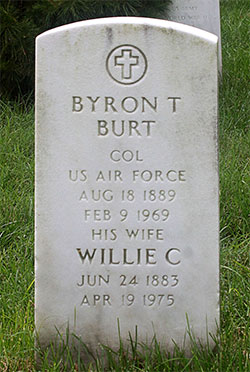 |
Byron Burt flew West as a retired colonel from Orange City, Florida on February 9, 1969, age 79. His obituary is below. The name "Cox" associated with Willie in the article is an error, I believe.
B.T. Burt, Obituary, Orlando Sentinel, February 11, 1969 (Source: newspapers.com)
| COL. BYRON T. BURT (Ret), 79, 2475 Temple Drive, Winter Park, died Sunday. A native of Turin, Italy, he moved to Winter Park in 1945. A graduate of Mining Engineering College in Mexico, he served as a balloon observer in World War I and was awarded the Distinguished Service Cross. Col. Burt later served on airships then transferred to airplanes, and also was a veteran of World War II. Services and burial will be at Arlington National Cemetery. Survivor: widow, Willie C. Cox |
Willie survived him by about six years, passing away in Orange City on April 19, 1975 and joining him at Arlingon National Cemetery. Their grave marker is at right.
---o0o---
THIS PAGE UPLOADED: 10/25/20 REVISED:
|













